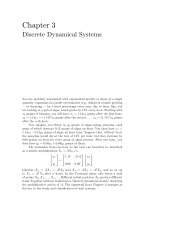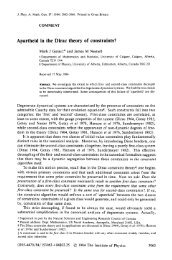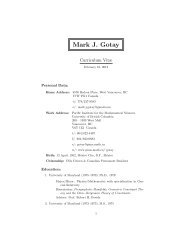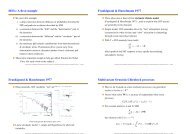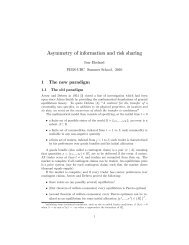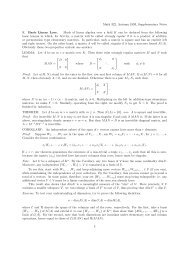53 PRIMA 2013 AbstractsPancyclicity of 4-connected {K 1,3, Z 8}-freegraphsHong-Jian Lai, Mingquan Zhan, Taoye Zhang, and JuZhouKutztown University of Pennsylvania, USAzhou@kutztown.eduA graph G is said to be pancyclic if G contains cycles oflengths from 3 to |V (G)|. In this paper, we show th<strong>at</strong>every 4-connected claw-free Z 8 -free graph is either pancyclicor is the line graph of the Petersen graph. Thisimplies th<strong>at</strong> every 4-connected claw-free Z 6 -free graph ispancyclic, and every 5-connected claw-free Z 8 -free graphis pancyclic.The number of subtrees of a treeXiao-Dong ZhangShanghai Jiao Tong University, P.R. Chinaxiaodong@sjtu.edu.cnIn this talk, we consider how to determine the maximumand minimum number of subtrees a tree with a givendegree tree sequence. It is proven th<strong>at</strong> the greedy treeamong all trees with the same degree sequence has themaximum number subtrees, while it is tough to determinewhich tree has minimum number of subtrees. This work isjoined with Daniel Gray, Hua Wang, and Xiu-Mei Zhang.Contributed Talks Group 4Comput<strong>at</strong>ional M<strong>at</strong>hem<strong>at</strong>ics & Optimiz<strong>at</strong>ionA semidefinite approxim<strong>at</strong>ion for symmetrictravelling salesman polytopesJulián Ariel Romero BarbosaUniversity of los Andes, Colombiaja.romero913@uniandes.edu.coIn this talk we will present a positive semidefinite approxim<strong>at</strong>ionof compact convex sets introduced by A. Barvinokand E. Veomett [1]. In particular we will discussthe behaviour of this relax<strong>at</strong>ion when the convex sets tobe approxim<strong>at</strong>ed are the Traveling Salesman PolytopesT n and T n,n associ<strong>at</strong>ed to the complete graphs K n andK n,n respectively. E. Veomett has shown th<strong>at</strong> the scalingof the k−th approxim<strong>at</strong>ion by n/k + O(1/n) containsthe polytope T n for k ≤ ⌊n/2⌉ . Here, we will showth<strong>at</strong>√these metric bounds can be improved by a factor of1 k−13 n2−1 + 2 for the case when n is even. Finally, we3will show new metric bounds for the approxim<strong>at</strong>ion ofthe polytope T n,n.This results are joint work with M. Velasco and are partof my master’s dissert<strong>at</strong>ion <strong>at</strong> the University of los Andes.[1] Veomett, Ellen. A positive semidefinite approxim<strong>at</strong>ionof the symmetric traveling salesman polytope. DiscreteComput. Geom. 38 (2007), no. 1, 15-28.An analysis of HDG methods for theHelmholtz equ<strong>at</strong>ionJintao CuiUniversity of Arkansas <strong>at</strong> Little Rock, USAjxcui1@ualr.eduIn this talk we discuss the hybridizable discontinuousGalerkin (HDG) methods for the Helmholtz equ<strong>at</strong>ionwith first order absorbing boundary condition in two andthree dimensions. We prove th<strong>at</strong> the proposed HDGmethods are stable (hence well-posed) without any meshconstraint. The stability constant is independent of thepolynomial degree. By using a projection-based erroranalysis, we also derive the error estim<strong>at</strong>es in L 2 norm forpiecewise polynomial spaces with arbitrary degree. Thisis joint work with Wujun Zhang from University of Maryland.An Uzawa method for solving steady Navier-Stokes equ<strong>at</strong>ions discretized by mixed elementmethodsJianguo HuangShanghai Jiao Tong University, Chinajghuang@sjtu.edu.cnNumerical solutions of Navier-Stokes equ<strong>at</strong>ions play fundamentalroles in scientific computing and fluid dynamics.The need to do this frequently occurs in many appliedsciences. Mixed element methods are widely usedfor discretizing steady Navier-Stokes equ<strong>at</strong>ions in applic<strong>at</strong>ions.However, it is challenging to devise fast solvers forthe resulting nonlinear system. A typical solver involvesnumerical solution of the discretized Oseen equ<strong>at</strong>ions <strong>at</strong>each iter<strong>at</strong>ion step; or equivalently, a non-symmetric saddlepoint system must be solved <strong>at</strong> each iter<strong>at</strong>ion step.However, it is by no means trivial to solve such a subproblemefficiently.In this talk, we are going to design an Uzawa-type iter<strong>at</strong>ivemethod for the previous nonlinear system, for whichwe require to solve no saddle point system <strong>at</strong> each iter<strong>at</strong>ionstep. Under some reasonable conditions, we prove itsconvergence r<strong>at</strong>e is independent of the finite element meshsize h, even for the shape regular triangul<strong>at</strong>ion. Finally,we provide a series of numerical experiments to show theaccuracy and performance of the method proposed. Thisis a joint work with Puyin Chen and Huashan Sheng.Semi-classical limit for the Schrödinger equ<strong>at</strong>ionwith l<strong>at</strong>tice potential, and band-crossingQin LiUniversity of Wisconsin-Madison, USAqinli@m<strong>at</strong>h.wisc.eduIn this talk, I am going to present the deriv<strong>at</strong>ion of thesemi-classical limit of the Schrödinger equ<strong>at</strong>ion with l<strong>at</strong>ticepotential, where the l<strong>at</strong>tice constant and the Planckconstant are <strong>at</strong> the same order. Bloch theory is used todecompose the solution into eigenfunctions. Here we encountertwo problems: 1. eigenvalues degener<strong>at</strong>e, whenthis happens one cannot distinguish the associ<strong>at</strong>ed eigenfunctions,and the so called transition r<strong>at</strong>e between energybands should be introduced; 2. the evolution of theprojection coefficients follow a coupled integro-differentialequ<strong>at</strong>ion, which can be hard to compute. By carryingout the Wigner transform<strong>at</strong>ion of all the Bloch bands,we find a complete basis on the phase space. The coefficientsfor them are controlled by a simple hyperbolicequ<strong>at</strong>ion, and the transition r<strong>at</strong>es <strong>at</strong> the point of thedegeneracy are characterized explicitly. A domain decompositionmethod based on the distances between energybands is designed associ<strong>at</strong>ed to this newly developedmodel. This is a joint work with Lihui Chai and Shi Jin.Legendre pseudospectral method for solvingthree-dimensional non-linear hyperbolic partialdifferential equ<strong>at</strong>ionsAbdur RashidGomal University, Pakistanprof.rashid@yahoo.com
54 PRIMA 2013 AbstractsIn this talk, numerical solutions of three-space non-linearhyperbolic partial differential equ<strong>at</strong>ions will be presentedby using Legendre pseudospectral method. The discretiz<strong>at</strong>ionof the sp<strong>at</strong>ial deriv<strong>at</strong>ives of the problem havebeen solved by using Legendre pseudospectral method. Asystem of non-linear ordinary differential equ<strong>at</strong>ions is gener<strong>at</strong>ed.The values of unknown function u can be foundby using kronecker product. The represent<strong>at</strong>ion of thiskind of product can easily be extended to higher dimensions.The numerical results are obtained and comparewith exact solutions to valid<strong>at</strong>e the high precision of theLegendre pseudospectral method [1-6].Efficient duality method to a class of globaloptimiz<strong>at</strong>ions problems with nonconvex objectivefunctionNing RuanUniversity of Ballar<strong>at</strong>, Australian.ruan@ballar<strong>at</strong>.edu.auIn this talk, the speaker presents a comprehensive reviewand some important developments on the canonicalduality theory for solving a broad classes of minimiz<strong>at</strong>ionproblem with nonconvex objective function. Theseproblems arise in many real-world applic<strong>at</strong>ions. By usingthe canonical dual transform<strong>at</strong>ion, the nonconvex primalproblem can be converted into a canonical dual problem(i.e., either a concave maximiz<strong>at</strong>ion or a convex minimiz<strong>at</strong>ionproblem) with zero duality gap. The idea and themethod presented in this talk can be generalized to solvemany other difficult problems in nonconvex mechanics,network communic<strong>at</strong>ion, and scientific comput<strong>at</strong>ions.M<strong>at</strong>h and gamingXingzhong ShiWenzhou-Kean University, Chinafshi_xz@yahoo.comM<strong>at</strong>h is indispensable and fundamental in computer videogames. Rel<strong>at</strong>ionship between M<strong>at</strong>h and game developmentis briefed. Computer video game classific<strong>at</strong>ion,computer programming languages for cre<strong>at</strong>ing computervideo games and some game API’s (Applic<strong>at</strong>ion ProgrammingInterfaces) and engines or libraries are introduced.Gaming elements rel<strong>at</strong>ed to M<strong>at</strong>h are identified. TheCartesian coordin<strong>at</strong>es in M<strong>at</strong>h and the Screen Coordin<strong>at</strong>eSystem in gaming are compared. The "Dark GDK"Library is used to demonstr<strong>at</strong>e how to draw basic shapesand cre<strong>at</strong>e interactive video games. Sample C++ programsand their results are shown for developing videogames using "DarkGDK", from basic 2-D shapes to interactivevideo games.Full Eulerian finite element methods for fluidstructureinteraction problem in fictitious domainand phase field approachesPengtao SunUniversity of Nevada Las Vegas, USApengtao.sun@unlv.eduIn this talk we will present a full Eulerian model for a dynamicfluid-structure interaction (FSI) problem by meansof Lagrange multiplier/fictitious domain approach andphase field formul<strong>at</strong>ion, and design its full Eulerian finiteelement discretiz<strong>at</strong>ion and effective iter<strong>at</strong>ive method. Inthe fictitious domain approach, the fluid domain and comput<strong>at</strong>ionalmesh are fixed by extending the fluid to thestructural domain, and the FSI interfacial conditions arereinforced by Lagrange multiplier. Thus an interpol<strong>at</strong>iontechnique is needed to interpol<strong>at</strong>e the fluid variables intothe structural domain. We also demonstr<strong>at</strong>e a method todeal with the incompressible fluid-compressible structureinteraction problem with fictitious domain approach.In the second approach-phase field formul<strong>at</strong>ion, the derivedfull Eulerian FSI model effectively demonstr<strong>at</strong>es theinteraction between fluid flow and solid structure in termsof an uniform system of governing equ<strong>at</strong>ions defined in asingle domain, thus the comput<strong>at</strong>ional grid is fixed, andthe re-meshing and interpol<strong>at</strong>ion techniques which are alwaysrequired by other FSI modeling approaches are nolonger needed here. A stabilized solution skill is developedto effectively solve the Euler equ<strong>at</strong>ion which is essentiallythe Eulerian description of solid motion for theincompressible hyperelastic m<strong>at</strong>erial. Numerical experimentis carried out for a cross spinning around its centralaxis due to the passing flow field, and the numerical resultsdram<strong>at</strong>ically show the spinning motion of the crossdue to the interaction with the fluid, showing th<strong>at</strong> ourmodel and numerical methods are effective to simul<strong>at</strong>ethe dynamic fluid-structure interaction phenomena.Linear numerical schemes for epitaxial thinfilm growth modelCheng WangUniversity of Massachusetts Dartmouth, USAcwang1@umassd.eduA few linear schemes for nonlinear PDE model of thinfilm growth model without slope selection are presentedin the talk. In the first order linear scheme, the idea ofconvex-concave decomposition of the energy functional isapplied, and the particular decomposition places the nonlinearterm in the concave part of the energy, in contrastto a standard convexity splitting scheme. As a result,the numerical scheme is fully linear <strong>at</strong> each time stepand unconditionally solvable, and an unconditional energystability is guaranteed by the convexity splitting n<strong>at</strong>ureof the numerical scheme. To improve the numericalaccuracy, a second order temporal approxim<strong>at</strong>ion for thenonlinear term is recently reported, which preserves anenergy stability. To solve this highly non-trivial nonlinearsystem, a linear iter<strong>at</strong>ion algorithm is proposed, withan introduction of a second order artificial diffusion term.Moreover, a contraction mapping property is proved forsuch a linear iter<strong>at</strong>ion. As a result, the highly nonlinearsystem can be decomposed as an iter<strong>at</strong>ion of purely linearsolvers. Some numerical simul<strong>at</strong>ion results are alsopresented in the talk.Applic<strong>at</strong>ion of MILP to solve complexscheduling problemsWei WengWaseda University, Japanwengwei@toki.waseda.jpThis talk describes the role of mixed integer linear programming(MILP) in solving scheduling problems in complexproduction processes such as reentrant flexible jobshops (RFJS). We modeled such scheduling problems byusing several different MILP models. The first model wasbased on the traditional way of MILP modeling, which denotesthe machines, workst<strong>at</strong>ions, jobs, oper<strong>at</strong>ions, andthe time slots th<strong>at</strong> arrange the oper<strong>at</strong>ions on each machine.The second model improved the efficiency of thetraditional design by reducing the variable for machinesthrough the rel<strong>at</strong>ionship between machines and oper<strong>at</strong>ions.The third model further and significantly reducedthe comput<strong>at</strong>ional complexity of the second model byutilizing the rel<strong>at</strong>ionship between jobs on the same machineto replace the role of time slots, which were commonlyused in previous studies. Accordingly, the improvedmodel can obtain the solution for RFJS problemswith dozens of jobs whereas the traditional model, in mostcases, is unable to obtain even a feasible solution for thesame problems.
- Page 2 and 3:
1PRIMA 2013-Table of ContentsTable
- Page 4 and 5:
3PRIMA 2013-OrganizationOrganizatio
- Page 6 and 7:
5PRIMA 2013-OrganizationYoshikazu G
- Page 8 and 9:
7PRIMA 2013-Useful InformationUsefu
- Page 10 and 11:
9PRIMA 2013-Useful InformationTaxi:
- Page 12 and 13:
11PRIMA 2013-Useful Informationmath
- Page 14 and 15:
13PRIMA 2013 Program-Schedule-at-a-
- Page 16 and 17:
15PRIMA 2013 Program-Monday, June 2
- Page 18 and 19:
17PRIMA 2013 Program-Monday, June 2
- Page 20 and 21:
19PRIMA 2013 Program-Monday, June 2
- Page 22 and 23:
21PRIMA 2013 Program-Monday, June 2
- Page 24 and 25:
23PRIMA 2013 Program-Tuesday, June
- Page 26 and 27:
25PRIMA 2013 Program-Tuesday, June
- Page 29 and 30:
28PRIMA 2013 Program-Tuesday, June
- Page 31 and 32:
30PRIMA 2013 Program-Tuesday, June
- Page 33 and 34:
32PRIMA 2013 Program-Wednesday, Jun
- Page 35 and 36:
34PRIMA 2013 Program- Thursday, Jun
- Page 37 and 38:
36PRIMA 2013 Program- Thursday, Jun
- Page 39 and 40:
38PRIMA 2013 Program- Thursday, Jun
- Page 41 and 42:
40PRIMA 2013 Program- Thursday, Jun
- Page 43 and 44:
42PRIMA 2013 Program- Friday, June
- Page 45 and 46:
44PRIMA 2013 Program- Friday, June
- Page 48 and 49:
1 PRIMA 2013 AbstractsContents1 Pub
- Page 50 and 51: 3 PRIMA 2013 Abstractsof subfactors
- Page 52 and 53: 5 PRIMA 2013 AbstractsprocessesXu S
- Page 54 and 55: 7 PRIMA 2013 AbstractsIn this talk
- Page 56 and 57: 9 PRIMA 2013 Abstractsindependently
- Page 58 and 59: 11 PRIMA 2013 AbstractsEnumerating,
- Page 60 and 61: 13 PRIMA 2013 AbstractsRyuhei Uehar
- Page 62 and 63: 15 PRIMA 2013 AbstractsIn this talk
- Page 64 and 65: 17 PRIMA 2013 AbstractsSpecial Sess
- Page 66 and 67: 19 PRIMA 2013 Abstractscritical slo
- Page 68 and 69: 21 PRIMA 2013 AbstractsSpecial Sess
- Page 70 and 71: 23 PRIMA 2013 Abstractsstrictly awa
- Page 72 and 73: 25 PRIMA 2013 AbstractsPedram Hekma
- Page 74 and 75: 27 PRIMA 2013 Abstractsis well-know
- Page 76 and 77: 29 PRIMA 2013 Abstractssolid substr
- Page 78 and 79: 31 PRIMA 2013 AbstractsRapoport-Zin
- Page 80 and 81: 33 PRIMA 2013 Abstractssense. Our a
- Page 82 and 83: 35 PRIMA 2013 AbstractsIn an econom
- Page 84 and 85: 37 PRIMA 2013 AbstractsKyoto Univer
- Page 86 and 87: 39 PRIMA 2013 AbstractsAlexander Mo
- Page 88 and 89: 41 PRIMA 2013 AbstractsOsamu SaekiK
- Page 90 and 91: 43 PRIMA 2013 Abstractsopen Delzant
- Page 92 and 93: 45 PRIMA 2013 AbstractsJian ZhouTsi
- Page 94 and 95: 47 PRIMA 2013 AbstractsJiaqun WeiNa
- Page 96 and 97: 49 PRIMA 2013 Abstractsthe end of 2
- Page 98 and 99: 51 PRIMA 2013 AbstractsJongyook Par
- Page 102 and 103: 55 PRIMA 2013 AbstractsEfficient nu
- Page 104 and 105: 57 PRIMA 2013 Abstractsand fountain
- Page 106: 59 PRIMA 2013 Abstractsformula esti



